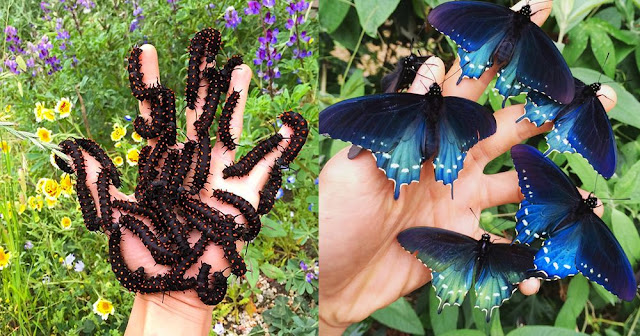“Sometimes I wonder whether the world is being run by smart people who are putting us on or by imbeciles who really mean it.”
~ Laurence J. Peter, The Peter Principle
Eight new chrysalides, of which four eclosed and were released Friday. Released sixteen so far this season.
The Xerces Society has published the "State of the Monarch Butterfly Overwintering Sites in California" report recently, which you can access here:
The report shows a sharp two-decade decline in the number of monarchs which overwinter along the California coast and prioritizes the top 50 overwintering sites most in need of conservation and management attention. State of the Monarch Butterfly Overwintering Sites in California provides an analysis of western monarch population trends. A comparison of the average number of butterflies overwintering in California during the periods 1997–2001 and 2010–2014 shows a decline of 74% since the late 1990s, a figure that is comparable to declines documented at monarch overwintering sites in Mexico.
For those that have a penchant for Monarch butterflies, this report is a must read and worthy of keeping for future reference.
Let's not forget the potential downsides of planting year-round milkweeds in our gardens. If possible, stick with native milkweeds, preferably ones native to your area. If you do grow perennial milkweeds such as Asclepias curassavica and wish to keep growing it, it's highly recommended to cut them way back each fall and winter to minimize unnatural overwintering of migratory Monarchs:
Another Damning Research Paper...
~ Laurence J. Peter, The Peter Principle
Eight new chrysalides, of which four eclosed and were released Friday. Released sixteen so far this season.
The Xerces Society has published the "State of the Monarch Butterfly Overwintering Sites in California" report recently, which you can access here:
The report shows a sharp two-decade decline in the number of monarchs which overwinter along the California coast and prioritizes the top 50 overwintering sites most in need of conservation and management attention. State of the Monarch Butterfly Overwintering Sites in California provides an analysis of western monarch population trends. A comparison of the average number of butterflies overwintering in California during the periods 1997–2001 and 2010–2014 shows a decline of 74% since the late 1990s, a figure that is comparable to declines documented at monarch overwintering sites in Mexico.
For those that have a penchant for Monarch butterflies, this report is a must read and worthy of keeping for future reference.
Let's not forget the potential downsides of planting year-round milkweeds in our gardens. If possible, stick with native milkweeds, preferably ones native to your area. If you do grow perennial milkweeds such as Asclepias curassavica and wish to keep growing it, it's highly recommended to cut them way back each fall and winter to minimize unnatural overwintering of migratory Monarchs:
Another Damning Research Paper...
For
some more exciting municipal government news, the City of Oakland,
California has stepped up to the plate in support of our native
butterflies and other pollinators through their system of city parks, via one of
their employees, Park Supervisor Tora Rocha.
 |
| -https://www.gardentribe.com/ |
Victoria 'Tora' Rocha. Park Supervisor, City of Oakland, California
 |
Tora
has been instrumental in introducing and cultivating pollinator plants
in her parks with blessings from city management. Not only that, but the
City of Oakland even allows volunteer citizen groups to help out in the
parks. Not a new concept, but a very foreign notion to some municipalities; at least to
the City of Laguna Beach, apparently.
 |
| -http://www.pacifichorticulture.org |
Garden volunteers at Oakland's Gardens at Lake Merritt.
For
those that know me and have been following this blog for some time, I
have been at odds with the CLB (City of Laguna Beach) management regarding planting for butterflies
and the use of citizen gardening volunteers, ever since I was employed as
a Parks Gardener there. Hopefully, citizen awareness and a grass roots
movement may sway city fathers to reconsider their aversion to the
concept.
For more information on Tora Rocha:
Will someone please help take over this abandoned Laguna Beach butterfly garden? The current city gardener is doing his best maintaining and improving it, given the allotted time, resources, and management indifference he must contend with:
http://lagunadirt.com/2012/04/a-butterfly-garden-with-a-mission.html




















